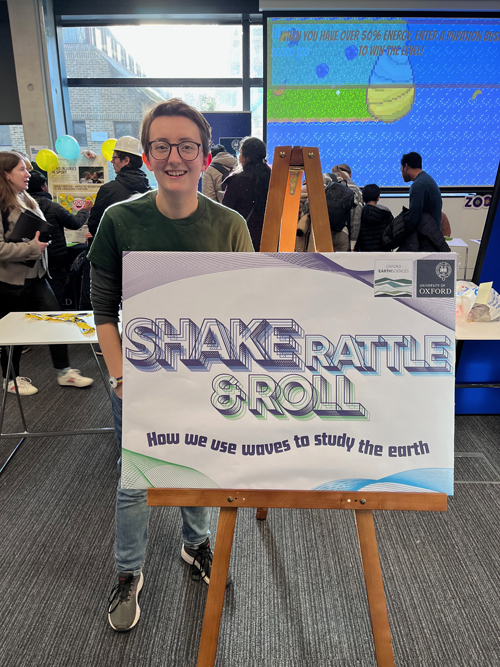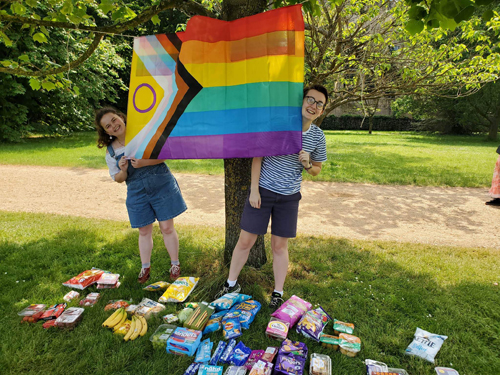11 April 2025—Rebecca Colquhoun liked math and science in school but wasn’t sure what kind of career that might launch. Should they go into physics? Chemistry? Computer science?
“I was looking for something that was sort of a mixture, so I could put off deciding for a while longer,” Colquhoun jokes. “Once I understood Earth sciences was a thing, I always wanted to be a seismologist.”

Colquhoun, who is finishing their Ph.D. at the University of Oxford this spring, will be returning to the lecture hall later this year as they take a position as a permanent teaching fellow in geophysics at Imperial College London.
A year-long teaching fellowship at Imperial, in the middle of their Ph.D., convinced them that teaching was the right path, Colquhoun says.
“I really like that moment when you’re explaining something to students or you’re working through a problem that they’ve got, and suddenly there’s that moment where it clicks,” they say. “And you can see that understanding arrive … it’s exciting to see people build their own knowledge.”
Colquhoun’s Ph.D. research centers on earthquake determinism, “or what are the intrinsic differences between big and small earthquakes, or indeed are there intrinsic differences?” they explain. “One of the ways I often frame it is, ‘how quickly can you tell how big an earthquake will be?’”
Their project analyzes a global dataset of earthquakes of different magnitudes, examining the first tenths of a second of each rupture with the hopes of understanding what different physics might be at work in small versus large earthquakes.
“Statistically, we see some differences between a magnitude 3 and a magnitude 7,” they conclude, “but the variation between earthquakes is much bigger than the variation that’s caused by the magnitude, so that makes it really hard to use it predictively.”
“On average, magnitude 7 earthquakes release moment more quickly in their initial stages than a magnitude 3,” they add, “but not in a way that you can measure the moment in the first .3 seconds and that’s going to absolutely tell you how big this event will be.”
The project sent Colquhoun back into the seismological literature of the 1970s and 1980s, they say, when there was more interest in fundamental physics research related to earthquake rupture. “The advent of lots of data got everyone excited about other things for a while, but now I think many of us are now going back to thinking more about physics,” they note.
One of the goals Colquhoun has as a lecturer will be to convince more students to go into the geosciences, especially geophysics. Some of the reasons students may be reluctant, they say, is that the field is “perceived as too difficult, or that if you like maths, you should be doing something like pure physics first. There can also be a ‘straight white man in hiking boots persona’ that is associated with geosciences.”
At Oxford, where Colquhoun received their undergraduate and master’s degrees as well, they have worked in several ways to make the field more inclusive and welcoming. They contributed to a report that made recommendations for improving racial equality, diversity and inclusion in the Department of Earth Sciences. They were co-leader of the department’s Unlearning Racism in Geoscience Group (URGE) and worked with the department’s Athena Swan charter to advance gender equality in science fields. Their work in equality, diversity and inclusion was commended in the student champion category of University of Oxford’s Vice Chancellor’s Diversity Awards in 2022, the same year URGE won the Vice Chancellor’s Inclusive Culture award.

Coming up with specific deliverables and providing resources on inclusion “make the barriers to changing things much lower,” they say. “The goal is to make the department as welcoming as possible.”
To build a community for queer scientists in the department, Colquhoun and colleagues also set up an LGBTQIA+ affinity group that offers both events for LGBTQIA+ members of the department, to foster community and solidarity, as well as informal educational events for the wider department at morning coffee breaks.
As the Ph.D. finish line approaches, Colquhoun is starting to think more about “working out how to best teach maths to people who don’t like maths, and getting people enthused about the most quantitative aspects of geoscience.”
“This will let us solve much more exciting problems, because it makes us much more interdisciplinary,” they suggest. “And I think that’s what our research looks like in the future.”
SSA At Work is a monthly column that follows the careers of SSA members. For the full list of issues, head to our At Work page.
